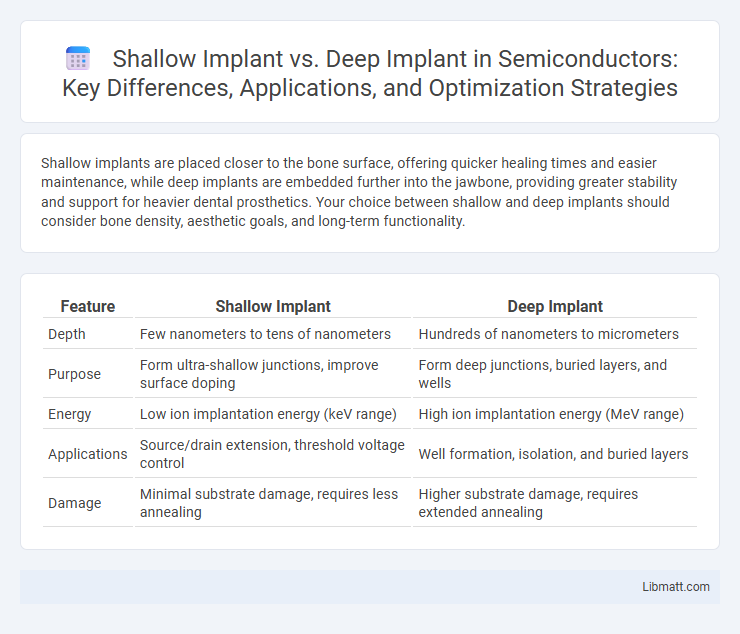Shallow implants are placed closer to the bone surface, offering quicker healing times and easier maintenance, while deep implants are embedded further into the jawbone, providing greater stability and support for heavier dental prosthetics. Your choice between shallow and deep implants should consider bone density, aesthetic goals, and long-term functionality.
Table of Comparison
| Feature | Shallow Implant | Deep Implant |
|---|---|---|
| Depth | Few nanometers to tens of nanometers | Hundreds of nanometers to micrometers |
| Purpose | Form ultra-shallow junctions, improve surface doping | Form deep junctions, buried layers, and wells |
| Energy | Low ion implantation energy (keV range) | High ion implantation energy (MeV range) |
| Applications | Source/drain extension, threshold voltage control | Well formation, isolation, and buried layers |
| Damage | Minimal substrate damage, requires less annealing | Higher substrate damage, requires extended annealing |
Introduction to Shallow and Deep Implants
Shallow implants are positioned closer to the bone surface, offering easier access and typically faster integration, suitable for patients with limited bone depth. Deep implants are anchored deeper into the bone, providing increased stability and support for larger prosthetics, ideal for cases requiring enhanced load distribution. Understanding the differences between shallow and deep implants helps you choose the most effective dental solution based on your bone structure and treatment goals.
Defining Shallow Implants
Shallow implants are dental fixtures positioned closer to the bone surface, typically involving minimal invasion of the underlying bone tissue. This placement technique reduces surgical complexity and promotes faster healing compared to deep implants, which are embedded deeper within the bone structure. Shallow implants are often favored for patients with limited bone density or those seeking less invasive dental restoration options.
Understanding Deep Implants
Deep implants are placed deeper into the bone tissue, providing enhanced stability and support for dental prosthetics compared to shallow implants. This increased depth allows for better osseointegration, which improves the longevity and strength of the implant, especially in patients with limited bone density. Deep implants are often recommended for cases requiring greater anchorage and durability in complex dental restorations.
Key Differences Between Shallow and Deep Implants
Shallow implants are positioned closer to the bone surface, offering quicker integration and potentially less discomfort during healing, while deep implants are embedded more extensively into the bone for enhanced primary stability and load distribution. The choice between shallow and deep implants depends on factors such as bone density, anatomical constraints, and the intended load-bearing requirements of the prosthetic restoration. Clinical outcomes indicate that deep implants provide greater mechanical anchorage in dense bone, whereas shallow implants minimize surgical trauma in softer bone conditions.
Indications for Shallow Implant Placement
Shallow implant placement is primarily indicated for patients with limited bone height or density, especially in regions where vital anatomical structures such as the maxillary sinus or inferior alveolar nerve are near the implant site. This technique is preferred in cases requiring minimal surgical intervention and when achieving primary stability without extensive bone augmentation is critical. You should consider shallow implants when preserving surrounding bone and reducing postoperative complications are priorities.
Indications for Deep Implant Placement
Deep implant placement is indicated for patients with limited bone height in the alveolar ridge, where increased stability and load distribution are essential. It is often chosen in cases of severe bone resorption, to avoid vital anatomical structures such as the maxillary sinus or inferior alveolar nerve. Deep implants provide enhanced osseointegration in compromised bone conditions, supporting long-term prosthetic success.
Advantages of Shallow Implants
Shallow implants provide easier surgical access and reduced risk of damaging adjacent anatomical structures such as nerves and sinuses. These implants typically allow for faster healing times and less post-operative discomfort due to minimal bone penetration. Their design facilitates better maintenance and cleaning, promoting longer-term implant stability and success.
Benefits of Deep Implants
Deep implants offer enhanced stability and durability by anchoring more securely into the bone, reducing the risk of implant failure. They provide better load distribution, which minimizes stress on surrounding tissues and promotes faster osseointegration. Your dental health benefits from improved long-term support and a more natural feel compared to shallow implants.
Potential Risks and Complications
Shallow implants may increase the risk of insufficient bone integration and implant mobility, potentially leading to early failure or peri-implantitis due to poor stability. Deep implants present a higher risk of damaging adjacent anatomical structures such as nerves or sinus cavities, which can result in chronic pain or sensory disturbances. Careful planning and imaging techniques like CBCT are crucial to minimize complications associated with implant depth.
Choosing the Right Implant Depth: Patient Considerations
Selecting the appropriate implant depth involves evaluating bone density, anatomical landmarks, and soft tissue thickness to ensure optimal osseointegration and esthetic outcomes. Shallow implants are often preferred for patients with limited bone volume or proximity to critical structures, reducing surgical risks and promoting faster healing. Deep implants may provide enhanced stability in cases with robust alveolar bone but require careful assessment to avoid complications such as nerve damage or sinus perforation.
Shallow Implant vs Deep Implant Infographic

 libmatt.com
libmatt.com